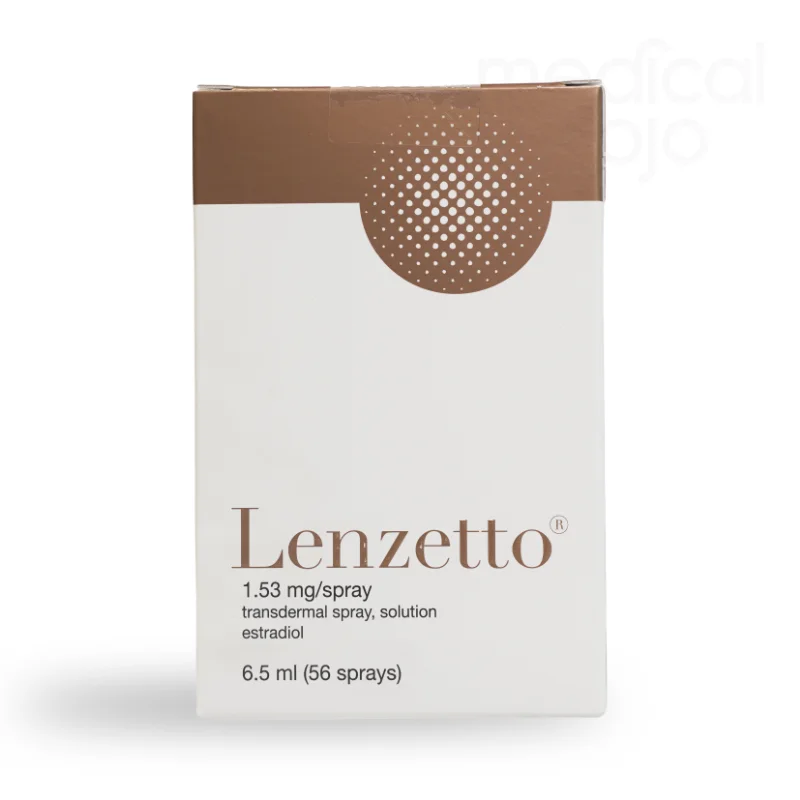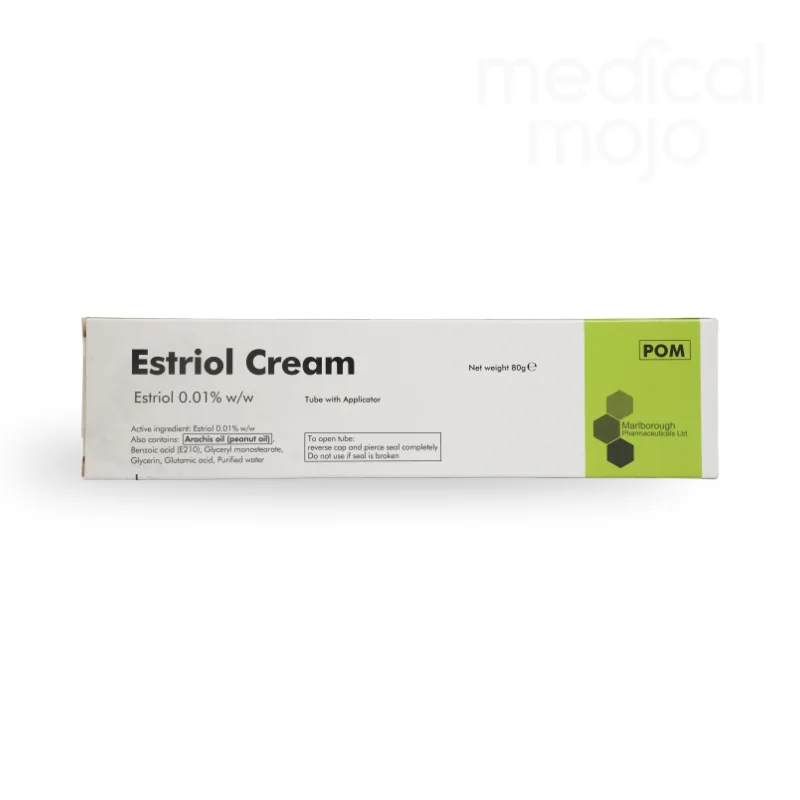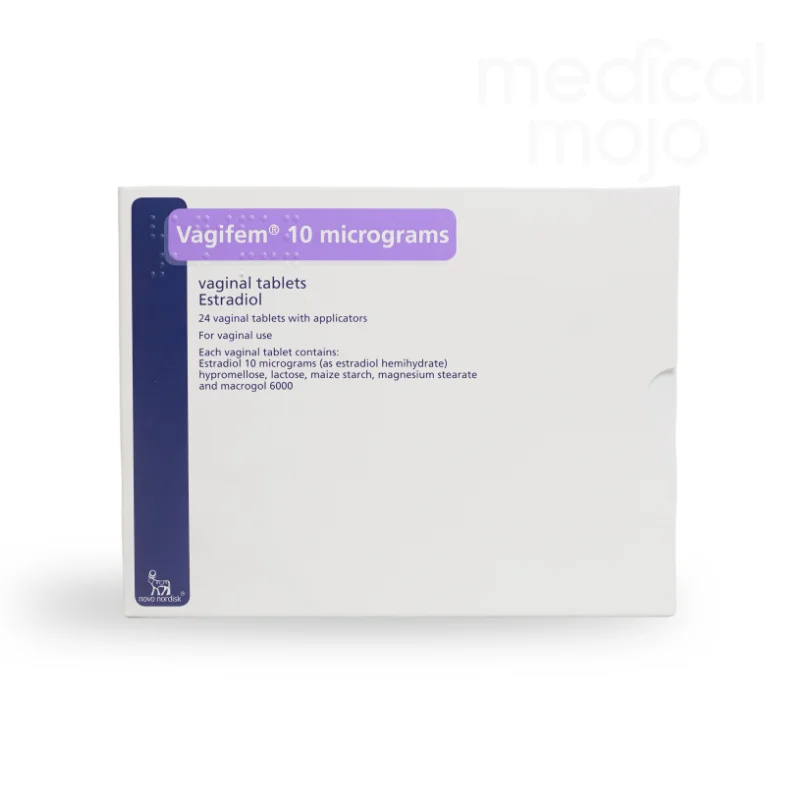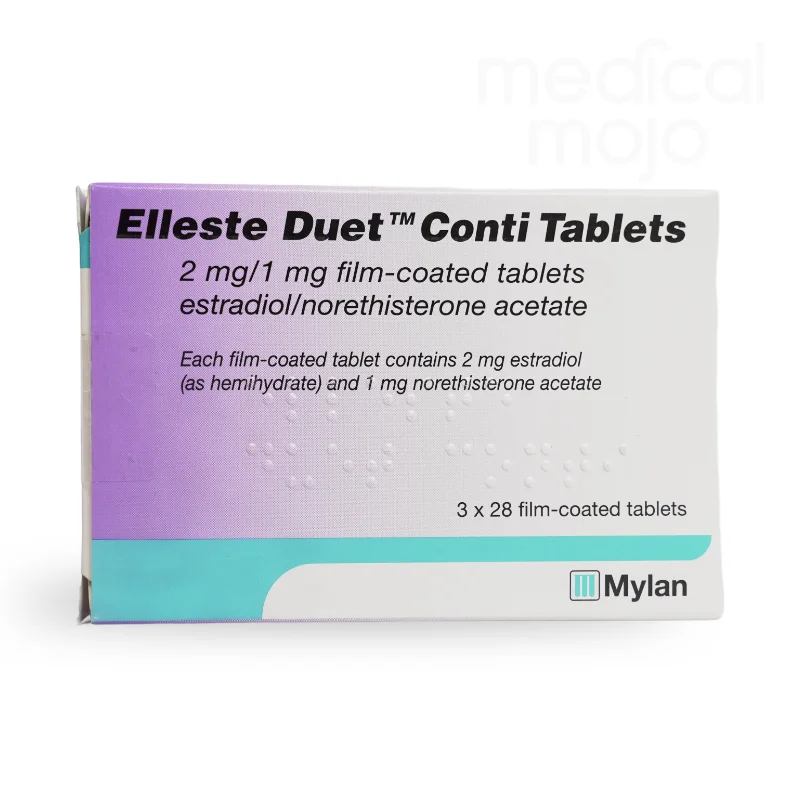What is Lenzetto spray?
Lenzetto is a Hormone Replacement Therapy (HRT) that contains the female hormone oestrogen. It is intended for use in postmenopausal women who have not had a natural period for at least 6 months. Lenzetto can also be used by women who have undergone surgery to remove their ovaries, leading to an immediate onset of menopause. Lenzetto is administered as a spray solution containing estradiol. When applied to the skin as directed, the estradiol is absorbed through the skin and into the bloodstream.
What is the active ingredient in Lenzetto spray?
Lenzetto Spray active ingredients: estradiol hemihydrate.
What is Lenzetto spray used for?
Lenzetto is a Hormone Replacement Therapy (HRT) containing the female hormone oestrogen. It is designed for postmenopausal women who have not had a natural period for at least 6 months. Lenzetto is also suitable for women who have undergone surgery to remove their ovaries, which triggers immediate menopause.
Lenzetto is administered as a spray solution containing small amounts of estradiol. When applied to the skin as directed, the estradiol is absorbed through the skin and into the bloodstream.
Uses of Lenzetto:
- Relief of Menopausal Symptoms: Lenzetto is used to alleviate symptoms associated with menopause, such as hot flushes, which occur when the body's oestrogen levels decrease. It is prescribed when these symptoms significantly impact daily life.
- Treatment of Oestrogen Deficiency: Lenzetto treats symptoms of oestrogen deficiency after menopause, including hot flushes, sleep disturbances, irritability, and vaginal dryness.
The experience of using Lenzetto in women over 65 years old is limited, and it is important to note that Lenzetto is not a contraceptive.
How does Lenzetto spray work?
Lenzetto spray works by delivering a form of the female hormone oestrogen, called estradiol, directly into your bloodstream through the skin. As a woman goes through menopause, her body produces less oestrogen, which can lead to symptoms such as hot flushes, night sweats, and vaginal dryness.
When Lenzetto spray is applied to the skin, the estradiol is absorbed and helps to replenish the body's oestrogen levels. This increase in oestrogen alleviates menopausal symptoms by restoring hormonal balance, thereby improving comfort and quality of life for postmenopausal women.
How do you use Lenzetto spray?
Always use this medicine exactly as your doctor has instructed. If you are unsure, consult your doctor or pharmacist.
Your doctor will aim to prescribe the lowest effective dose to manage your symptoms for the shortest time necessary. During treatment, your doctor may adjust the dose according to your individual needs. If you think the dose is too strong or too weak, speak to your doctor.
If you have not had a hysterectomy (surgery to remove your womb), your doctor will prescribe additional tablets containing a hormone called progestogen to balance the effects of oestrogen on the lining of your womb. Your doctor will explain how to take these tablets. You may experience withdrawal bleeding at the end of the progestogen treatment period.
If You Need Surgery
If you are scheduled for surgery, inform your surgeon that you are using Lenzetto. You may need to stop using Lenzetto about 4 to 6 weeks before the operation to reduce the risk of blood clots. Ask your doctor when you can resume using Lenzetto.
Where to Apply Lenzetto
Apply the spray to clean, dry, and healthy skin on the inner forearm. If this is not possible, apply it to the inner thigh. Do not apply Lenzetto to your breasts or near the breast area.
How to Apply Lenzetto
Before using a new applicator for the first time, prime the pump by spraying three times with the cover on:
- Hold the container upright. With the cover on, press the button down three times using your thumb or index finger. The medicine is now ready to use.
- Note: You do not need to prepare the applicator before each dose—only before starting a new container. If you miss one or more doses, prime the applicator as instructed.
Ensure the skin where you want to spray the medicine is clean, dry, and healthy.
Applying Your Daily Dose
- Remove the plastic cover, hold the container upright, and place the plastic cone flat against the skin.
- You may need to adjust the cone so it is flat against your skin with no gaps.
- Press the actuator button down fully and hold it down before releasing.
- If more than one spray is required, move the cone along your arm to a new spot and press the button down again. If necessary, you can use your other inner forearm or the inner surface of your thigh.
- After applying the spray, replace the cover on the container.
Let the spray dry for at least 2 minutes before dressing and wait at least 60 minutes before bathing or washing. If you accidentally get Lenzetto on another area of your skin, wash that area immediately with soap and water. Do not massage or rub Lenzetto into the skin.
How Much Lenzetto to Use
Your doctor will likely start you on the lowest dose (one spray per day). If necessary, your doctor may increase the dose to two sprays per day, with a maximum of three sprays per day.
Frequency of Use
Apply the total number of sprays prescribed by your doctor at the same time each day.
Duration of Use
Discuss with your doctor every 3-6 months how long you should continue using Lenzetto. Use Lenzetto only for as long as needed to relieve menopausal symptoms.
Additional Information
- Sunscreens can alter the absorption of oestrogen from Lenzetto. Avoid using sunscreen on the area where you intend to spray Lenzetto, or apply sunscreen at least one hour before using Lenzetto.
- Use Lenzetto with caution in extreme temperature conditions, such as sauna use or sunbathing.
- Overweight or obese women may experience reduced absorption of Lenzetto. Consult your doctor if you have concerns.
If You Use More Lenzetto Than You Should
If you use more Lenzetto than prescribed or if a child accidentally uses the medicine, contact your doctor or hospital immediately for advice. Overuse may cause nausea, vomiting, and unusual vaginal bleeding.
If You Forget to Use Lenzetto
If you forget to use Lenzetto, apply the spray as soon as you remember, then continue with your usual routine. If it’s nearly time for your next dose, skip the missed dose and continue as normal. Do not double the dose to make up for a missed one. Missing a dose may increase the likelihood of breakthrough bleeding or spotting.
Stopping Lenzetto
When it’s time to stop using Lenzetto, your doctor will explain how to safely discontinue the treatment. If you have any further questions, consult your doctor or pharmacist.
What are the side effects with Lenzetto spray?
As with any medication, Lenzetto can cause side effects, although not everyone experiences them. The following conditions are reported more frequently in women using Hormone Replacement Therapy (HRT) compared to those who do not use HRT:
- Breast cancer
- Abnormal growth or cancer of the lining of the womb (endometrial hyperplasia or cancer)
- Ovarian cancer
- Blood clots in the veins of the legs or lungs (venous thromboembolism)
- Heart disease
- Stroke
- Gall bladder disease
- High blood pressure
- Liver problems
- High blood sugar
- Potential memory loss if HRT is started after the age of 65
Serious Side Effects Requiring Immediate Medical Attention
If you experience any of the following symptoms, seek immediate medical attention:
- Sudden chest pain
- Chest pain that spreads to your arm or neck
- Difficulty breathing
- Painful swelling and redness in the legs
- Yellowing of the eyes and face (jaundice)
- Unexpected vaginal bleeding or spotting after using Lenzetto for some time or after stopping treatment
- Changes in the breasts, such as dimpling of the skin, changes in the nipple, or lumps
- Painful menstrual periods
- Dizziness or fainting
- Changes in speech
- Changes in vision
- Unexplained migraine-like headaches
If any side effects become serious, or if you notice any side effects not listed in this leaflet, please inform your doctor or pharmacist.
Common Side Effects (May Affect Up to 1 in 10 People)
- Headache
- Abdominal pain
- Nausea
- Rash
- Itching (pruritis)
- Irregular uterine or vaginal bleeding, including spotting
- Breast tenderness or pain
- Weight gain or loss
Uncommon Side Effects (May Affect Up to 1 in 100 People)
- Hypersensitivity reactions
- Depressed mood
- Insomnia (difficulty sleeping)
- Dizziness or vertigo
- Visual disturbances
- Palpitations (feeling your heartbeat)
- Diarrhea or indigestion (dyspepsia)
- Increased blood pressure
- Erythema nodosum (painful reddish skin nodules)
- Hives (general or localized rash or lumps)
- Skin irritation
- Swelling due to fluid retention (edema)
- Muscle pain
- Breast discoloration or discharge
- Polyps (small growths) in the uterus or cervix
- Endometrial hyperplasia
- Ovarian cysts
- Inflammation of the genitals (vaginitis)
- Increased liver enzymes or blood cholesterol
- Underarm pain
Rare Side Effects (May Affect Up to 1 in 1000 People)
- Anxiety
- Changes in sexual drive (increase or decrease)
- Migraine
- Intolerance to contact lenses
- Bloating
- Vomiting
- Increased body hair or acne
- Muscle cramps
- Painful menstruation
- Premenstrual-like syndrome
- Breast enlargement
- Fatigue
Side Effects with Unknown Frequency
- Hair loss (alopecia)
- Chloasma (golden brown pigment patches, especially on the face)
- Skin discoloration
Other Reported Side Effects with HRT
- Serious allergic reactions causing swelling of the face or throat (angioedema)
- Anaphylactic reactions (serious allergic reactions causing difficulty in breathing or dizziness)
- Glucose intolerance
- Depression, mood disturbances, irritability
- Exacerbation of chorea (St. Vitus’s dance)
- Worsening of epilepsy
- Dementia
- Worsening of asthma
- Gall bladder disease
- Yellowing of the skin (jaundice)
- Inflammation of the pancreas
- Benign tumors of the uterus
- Various skin disorders, such as erythema nodosum, erythema multiforme, and skin rashes
- Joint pain
- Secretion of milk from the breast (not related to breastfeeding)
- Lumpy or painful breasts
- Increase in size of benign tumors in the uterus
- Changes in the cervix (neck of the womb)
- Vaginal inflammation or fungal infections (vaginal candidiasis)
- Abnormally low levels of calcium in the blood
Reporting Side Effects
If you experience any side effects, talk to your doctor or pharmacist. This includes any possible side effects not listed in this leaflet. You can also report side effects directly:
By reporting side effects, you can help provide more information on the safety of this medicine.











